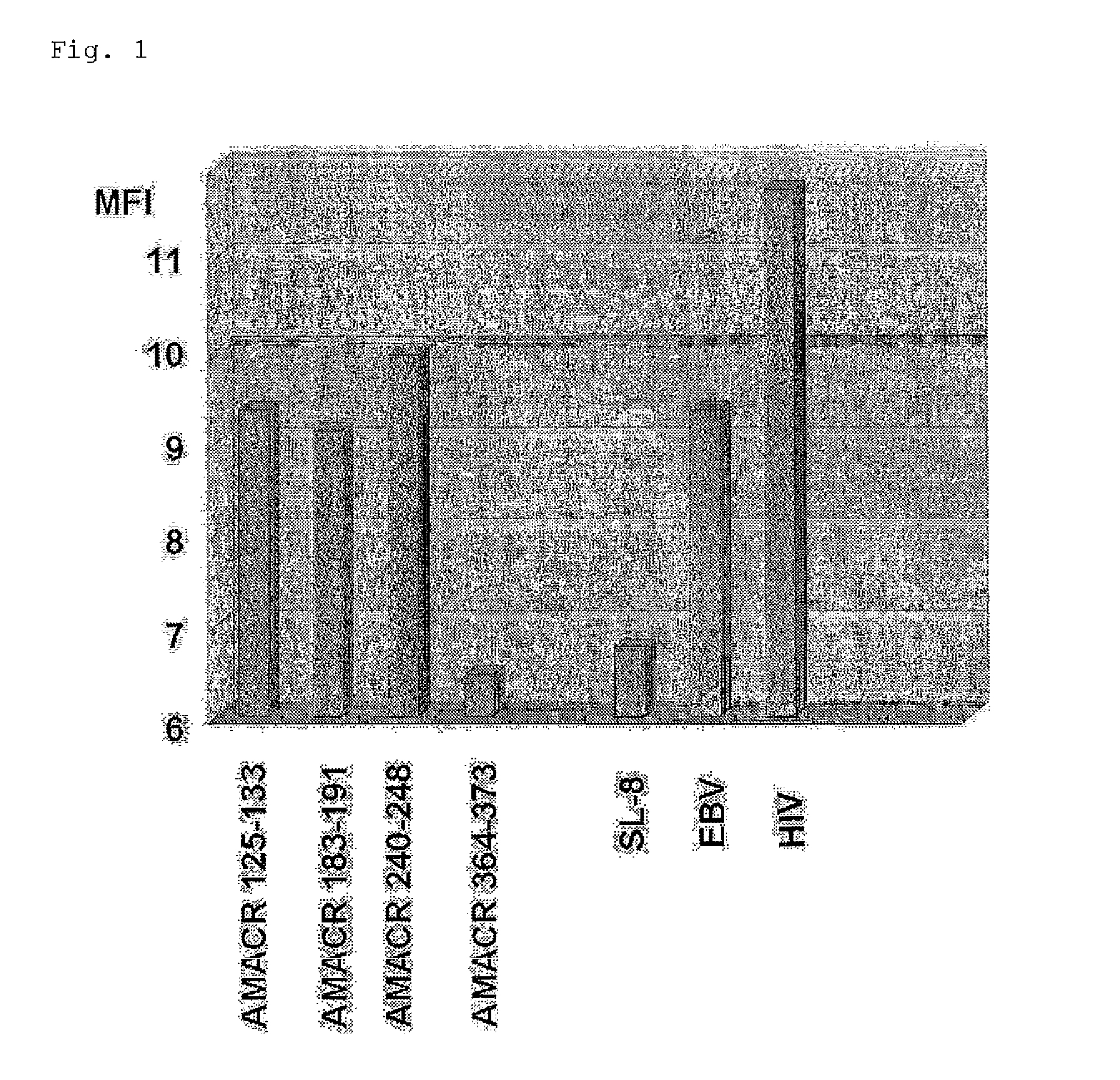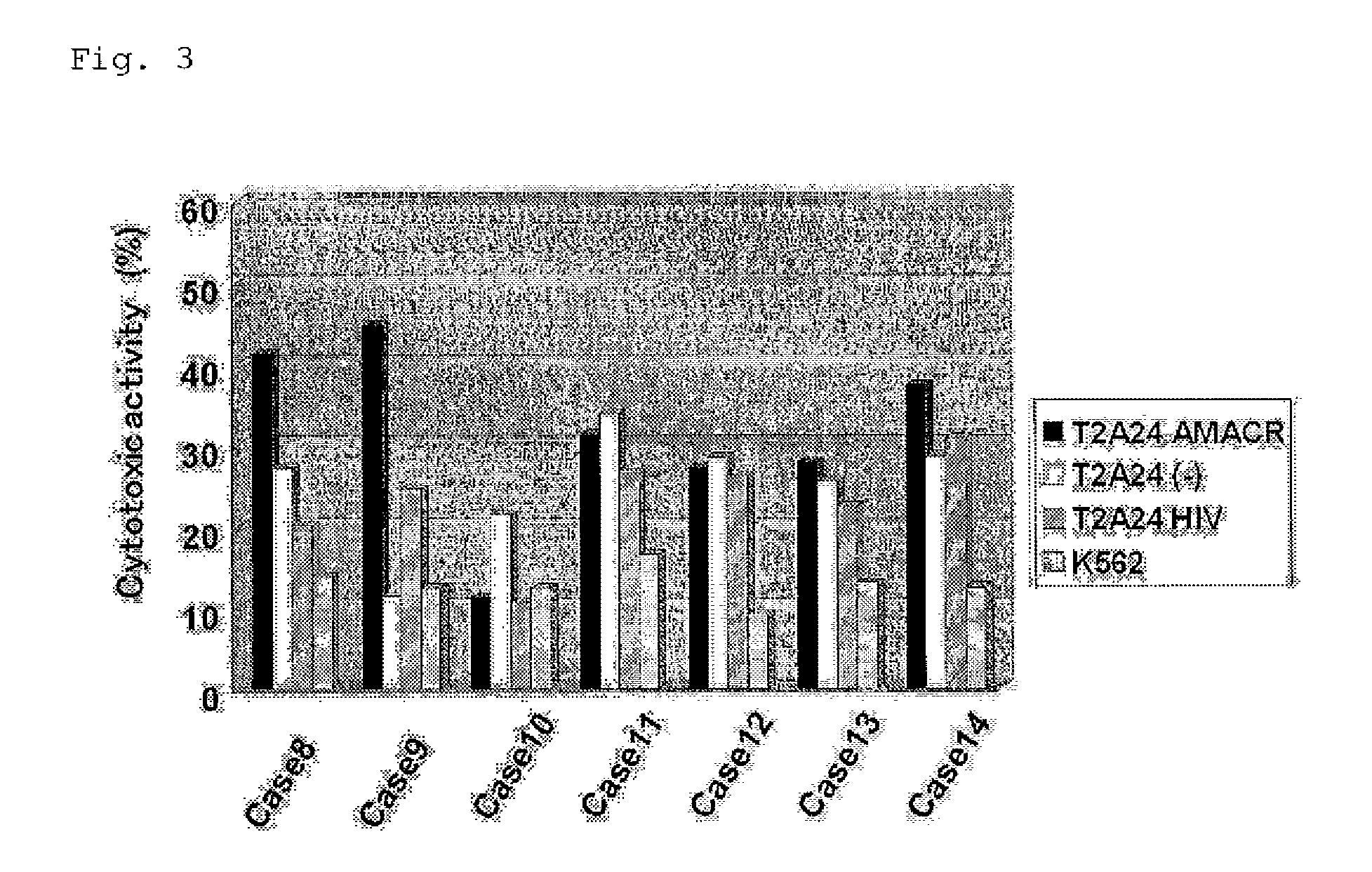Tumor antigen peptide derived from amacr
a technology of amacr and amacr, which is applied in the field of alphamethylacylcoa racemase, can solve the problem of not satisfying enough molecular-targeted agents
- Summary
- Abstract
- Description
- Claims
- Application Information
AI Technical Summary
Benefits of technology
Problems solved by technology
Method used
Image
Examples
example 1
Synthesis and Selection of Candidate Peptides
(1) Selection of Candidate Peptides
[0247]Peptides each consisting of any one of the amino acid sequences of SEQ ID NOS: 3 to 23 were selected as candidate peptides derived from the amino acid sequence of human AMACR (SEQ ID NO: 2) which were potential to bind to an HLA-A24 molecule. Further, Peptides each consisting of any one of the amino acid sequences of SEQ ID NOS: 24 to 33 were selected as candidate peptides which were potential to bind to an HLA-A2 molecule. The sequence of each of those peptides and the position on the sequence of AMACR are listed below.
TABLE 2AMACR A24 peptidesName of thepeptideSequenceSEQ ID NO:AMACR 18-22PFCAMVLADF7AMACR 115-124SFCRLAGHDI8AMACR 125-133NYLALSGVL3AMACR 158-166LMCALGIIM9AMACR 183-191NMVEGTAYL4AMACR 193-201SFLWKTQKL10AMACR 195-203LWKTQKLSL11AMACR 203-212LWEAPRGQNM12AMACR 211-219NMLDGGAPF13AMACR 221-229TYRTADGEF14AMACR 221-230TYRTADGEFM15AMACR 239-248QFYELLIKGL16AMACR 240-248FYELLIKGL5AMACR 258-267QM...
example 2
Evaluation of the Binding Affinity to HLA-A*2402 of the AMACR Antigen-Derived Peptide
[0249]The binding affinities to HLA-A*2402 of the peptides synthesized in Example 1 were determined by the method as described in a literature (J. Immunol. 164:2565, 2000). A cell line RMA-S-A*2402 cell, which was obtained by introducing a chimera MHC gene composed of HLA-A*2402 and H-2Kb into a mouse lymphoma cell line RMA-S lacking MHC class I molecule, was incubated at 26° C. for 18 hours. RMA-S-A*2402 cells were washed with PBS solution, suspended in culture solution OPTI-MEM (Invitrogen) containing 3 μL / mL human β2-microglobulin and 100 μL / mL each peptide, and incubated at 26° C. for 3 hours and at 37° C. for 3 hours. The cells were washed with PBS solution and treated with anti-HLA-A24 and anti-HLA-A2 antibodies at 4° C. for 30 minutes. Furthermore, the cells were washed with PBS solution, and treated with a PE-labeled anti-mouse IgG antibody at 4° C. for 30 minutes. The cells were washed, and...
example 3
CTL Induction By the AMACR Antigen-Derived Peptide From Human Peripheral Blood Mononuclear Cells (1)
[0251]A CTL was induced from peripheral blood mononuclear cells using the peptide AMACR 240-248 (SEQ ID NO: 5) that showed a strong binding activity to HLA-A*2402 in Example 2 according to the method as described in a literature (J. Immunol. 169:1611, 2002). After obtaining informed-consent, peripheral blood was collected from an HLA-A*2402-positive patient having prostate cancer, and mononuclear cells were separated by density gradient centrifugation method and cultured in AIM-V culture solution (Invitrogen). After 24-hour-cultivation, nonadherent cells were recovered and cultured in AIM-V containing 100 U / mL IL-2. For preparation of antigen-presenting cells, adherent cells were cultured in AIM-V culture solution containing 1000 U / mL IL-4 and 1000 U / mL GM-CSF for 5 days, and, after addition of 10 μM peptide, cultured for another 1 day. To the culture were then added 10 ng / mL TNF and ...
PUM
 Login to View More
Login to View More Abstract
Description
Claims
Application Information
 Login to View More
Login to View More - R&D
- Intellectual Property
- Life Sciences
- Materials
- Tech Scout
- Unparalleled Data Quality
- Higher Quality Content
- 60% Fewer Hallucinations
Browse by: Latest US Patents, China's latest patents, Technical Efficacy Thesaurus, Application Domain, Technology Topic, Popular Technical Reports.
© 2025 PatSnap. All rights reserved.Legal|Privacy policy|Modern Slavery Act Transparency Statement|Sitemap|About US| Contact US: help@patsnap.com



